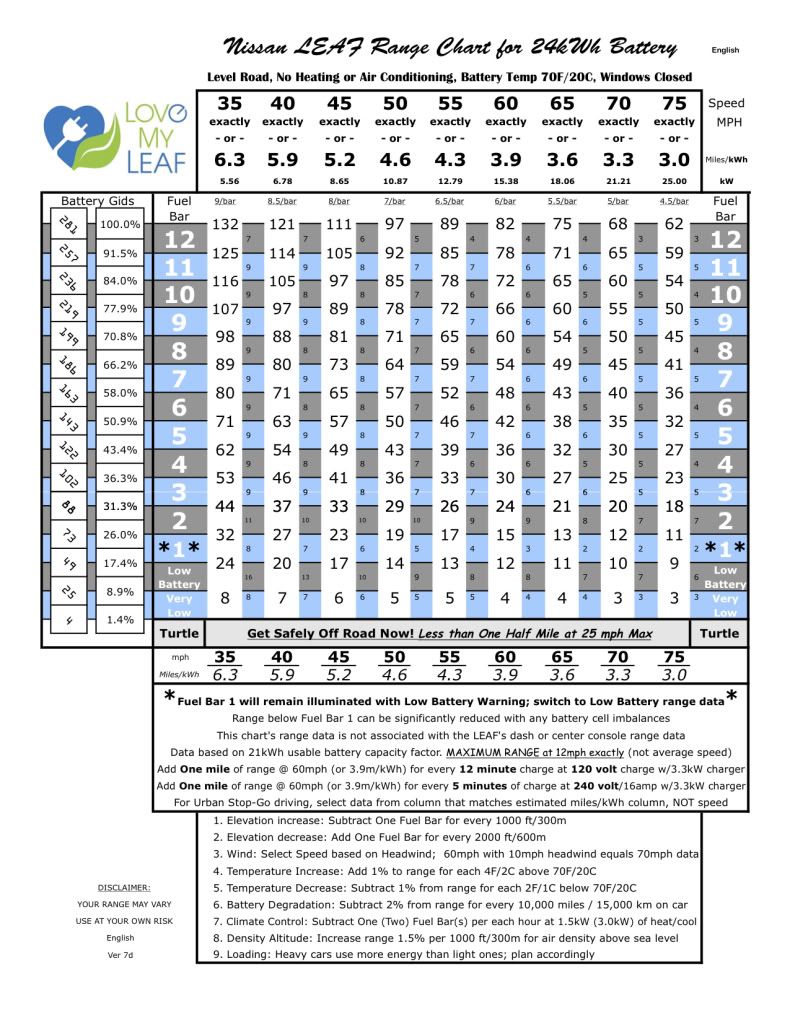NYLEAF said:
...is the mi/kwh shown on the Energy/Status screens accurate for use with the range chart?
That reading should be 0.1 miles/kWh higher than the dash mounted reading. Either is fine to use, to be honest, but my data is based on the lower dash mounted info.
I reset both at different times (a few days after getting the car), but after about a week of driving, they've both settled on 4.1 mi/kwh. So, if I multiply 4.1 times 21 (or really more like 18.9 since at 30F there's about a 10% reduction in available energy, right?), I should figure out how far I can go, assuming I keep that same average, correct?
You need to reset from the point where you'll be measuring. That is normally at a 100% or 80% charge. So, fuel up, reset which ever economy meter you wish to use, and use the chart to guess what your miles/kWh might be. Driving down a level road at sea level, with 70F battery temps, nil wind, no climate control, windows up, tires with 36psi or better, no aerodynamic changes to the car (like a roof mounted bike rack with 3 bikes on it), no exceptionally heavy load, etc....
Then, you should be able to count on 3.9 miles/kWh for that portion of the drive done at 60mph. What many folks don't factor is that if you plan 60mph, it might take some stop and go driving before you get to an open highway to drive 60mph. Depending how you drive, that can raise or lower your average when you finally get to 60mph at a steady speed. If you're curious, you can reset one of your economy meters once steady at 60mph on that flat, no wind highway, and it should settle in at 3.9miles/kWh over 10 or more miles. Of course, the center console data will be 0.1 higher, at 4.0.
To calculate your overall range, I think you got it right. Using the economy meter that was reset at 100%, simply multiply by 21. For 80% charges, use 17. So, 3.9*21=82 miles of range from 100% charge and 3.9*17 for 80%, or 66.3 miles.
Adjustments for temp are based on the battery temperature. Unfortunately, that's a bit difficult to determine without an accurate battery temperature gauge. Generally, if the car hasn't been charged or driven for 8 hours overnight, and was sitting outside, the battery is probably "cold soaked" at ambient air temperature. I say overnight, because even cold temps with the daytime sun's radiation will heat things up.
There is a consideration for cell balancing, but if the car was charged to 100%, and met the threshold for balancing, the BMS automation will do that over a time up to 4 hours after the 100% charge was completed. The car must have been left plugged in during this time.
So, back to your example, yes, 70F - 30F = 40 temperature delta / 4 is 10% reduction in battery capacity, and thus range. If your 60mph drive lasts one hour, you might use some climate control at 30F outside.
Your battery capacity is 21 - (21*0.1) = 18.9kWh, as you correctly calculated, leaving a 73.7 mile range (18.9*3.9). Don't subtract your heater use from your battery capacity, because it will be reflected in the lower economy, in addition to the lower economy just to extract the energy from the colder battery. I have no idea what might keep you comfy, but let's say you'll use an average of 2kW of heating. Over an hour, that's 2kWh used.
That should equal about a 10% loss of economy, from 3.9 down to 3.5 miles/kWh to travel that 60mph, multiplied by 18.9 battery capacity, will leave 66.1 miles of range (3.5*18.9).
Then, of course, whatever adjustments for elevation changes, headwinds, density altitude, gross vehicle weight, etc.
I've also read that the Carwings data differs from the car, and if I had a separate meter, or a Blink EVSE, or a TED device (I have none of these things), I would get different figures. My Carwings, at least for now, shows no data whatsoever (I do press OK every time I turn on the car, so I'm not sure what the issue is...)!
Yes, there are two versions of CarWings. Newer cars, and those with the 11-041 firmware update, are 2.5% off on miles traveled. Older cars are seemingly more accurate on mileage, but grossly off base on everything else. Data from a TED or Blink don't reflect charger inefficiency of 73% at 120v, and 84% at 240v.





